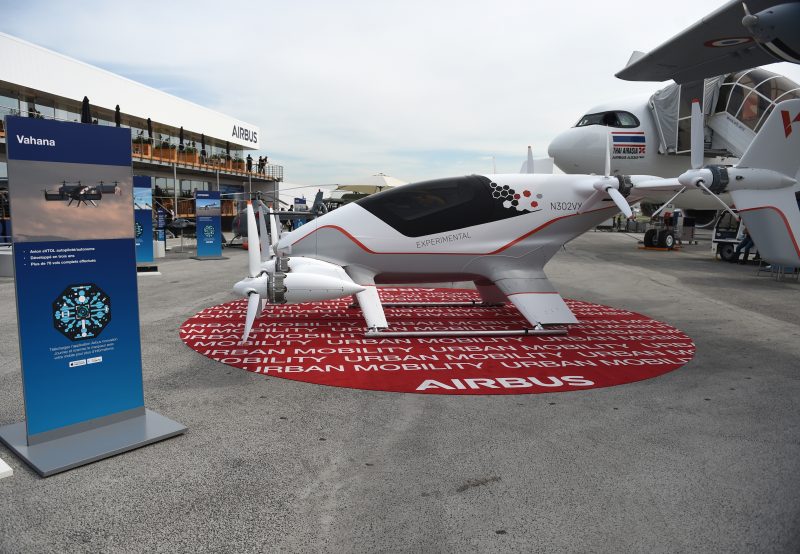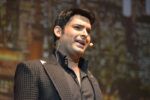Slashing plane emissions a lofty goal, but progress elusive
This Airbus all-electric, single-seater aircraft on show at the International Paris Air Show meets the emissions challenge, but the question is to transfer clean technology to the giant passenger jets (ERIC PIERMONT)
Le Bourget (France) (AFP) – The aircraft industry is facing growing criticism over greenhouse gas emissions that are set to soar as more people take to the skies, but experts say game-changing technology for cleaner planes is still decades away.
Dozens of firms at the Paris Air Show this week are touting their green credentials, with the industry pledging to halve its carbon dioxide emissions from 2005 levels by 2050.
From electric quadcopters to new engines powered by natural gas or hydrogen, the projects on display in Paris promise to revolutionise how people will eventually get across town or across the world.
In 2005, however, just 15,000 planes were in service, a number expected to jump to 40,000 over the next 20 years as demand for airline travel soars.
The industry has been increasing its fuel efficiency by just 1-2 percent a year over the past decade, mainly because airlines need to keep a lid on kerosene costs.
“It’s not environmental decency,” said Richard Aboulafia, an aviation expert at the Teal Group. “You have to burn less fuel, you just do, compared to your competition.”
The prospect of increasingly congested skies means improved traffic management could provide a quick efficiency boost, by making routes more direct and requiring fewer elevation changes midflight.
“We could lower fuel consumption by 10 percent if we optimised flight control,” said Nicolas Jeuland, a “future fuels” expert at French engine maker Safran.
But to meet the 2050 goal, engineers will have to overcome daunting hurdles to reduce the reliance on fossil fuels.
“We can’t just say that in 40 years will have the answers — we have to start working now,” Jeuland said.
– Electric dreams –
Batteries are a tempting alternative, either alone for smaller helicopters or in a hybrid system with traditional engines.
An EcoPulse jet project unveiled at the air show Monday aims to build a seven-propeller, six-seat jet by 2022 that could have a range of some 500 kilometres (310 miles).
“The electric motors are used at takeoff, which will make it less noisy, and then the combustion motor can recharge the electric batteries,” said Nicolas Orance of French aviation firm Daher, which is developing the project with Airbus and Safran.
Such planes could be particularly competitive for shorter flights in the US, which has few train networks between midsize cities.
But scaling up the electric idea to bigger planes will require a quantum leap in battery technology.
“If you wanted to fly a place like the A320, it’d need 170 tons of the best batteries available today — it’s impossible,” said Jeuland, referring to Airbus’s workhorse single-aisle passenger jet.
Batteries would also require engineers to redesign planes, which currently take off with a heavy fuel load but weigh much less when landing, after the tanks are nearly empty.
But batteries are heavy whether charged or not, and planes would likely need beefier landing gear to withstand the load.
“In the next four or five years, we’ll have batteries that can be recharged more quickly and will be lighter,” said Jerome Bouchard, an aviation expert at the consulting firm Oliver Wyman.
– Biofuels? –
Making synthetic jet fuel from plants like corn or jatropha has been proven to work, with Air France once highlighting a weekly Paris-Toulouse flight powered by biofuel.
The technology has the advantage of not requiring design overhauls of current planes, so the rollout could be made quickly.
But the carbon gains come upstream, as plants capture the carbon while growing — biofuels don’t burn any cleaner than traditional fossil fuels.
And they are much more expensive, costing at least twice as much as standard jet fuel, while some critics say turning over fields to biofuels reduces the amount of arable land needed to feed a rapidly developing world.
Bouchard estimates biofuels “will make up just a small fraction of a plane’s fuel mix,” from five to 30 percent at most.
– Hydrogen –
Hydrogen fuel cells offer the promise of slashing carbon emissions, since it mainly produces just water as a byproduct.
Hydrogen-powered motors are also more powerful than battery versions while offering longer operating range and being easier to refuel — as automakers have already discovered in recent years.
“A hydrogen airplane is the ideal solution in the future, but it’s far from simple,” Jeuland said.
The gas would need to be stored cryogenically as a liquid for fuel cells, and huge amounts would be needed to power larger planes.
“Again it’s a problem of mass, because the volume of hydrogen needed is four to six times the volumes required for jet fuel,” said Bouchard.
The same problem applies to natural gas, which burns cleaner than jet fuel but would require major design overhauls for planes.
Disclaimer: Validity of the above story is for 7 Days from original date of publishing. Source: AFP.


